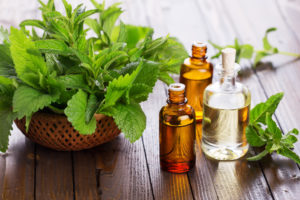
LINALOOL (Ex. Basil Oil)
Basil Essential Oil is amongst the oils that I immediately think of when I want an oil that can help stimulate my mind and allow me to focus on the task at hand. Basil Oil is an energizing oil and is best used during the morning and daytime hours.
Basil Essential Oil tends to be one of the first oils that I select when I have a cold. It is considered anti-bacterial/anti-viral, it acts as an expectorant and it also helps keep me alert. Basil Oil is also said to help with headaches, though it’s not one I commonly use for that purpose.
The chemical composition of Basil Essential Oil can vary greatly between varities, batches and suppliers. Ideally, look for Basil Essential Oil that has a a significant percentage of Linalool and that is weak in Methyl Chavicol (Estragole), a suspected carcinogen. Basil Oils that are higher in Linalool tend to have a more appealing aroma. Additionally, Linalool is said to act as an insect repellent.
Though I love Basil, I rarely use it alone. Instead I typically enjoy the most benefit from it as a part of a synergistic blend. But beware… Basil can easily dominate a blend. Go easy on the ratio of Basil Oil that you add to blends until you are more familiar with working with it, and be sure to heed all safety precautions.
Botanical Name
Ocimum basilicum
Common Method of Extraction
Steam Distilled
Part Typically Used
Leaves and Flowers/Buds
Color
Clear
Consistency
Thin
Perfumery Note
Top
Strength of Initial Aroma
Medium
Aromatic Description
Sweet, herbaceous, licorice-like, slightly campherous.
Basil Oil Uses
Bronchitis, colds, coughs, exhaustion, flatulence, flu, gout, insect bites, insect repellent, muscle aches, rheumatism, sinusitis. [Julia Lawless, The Illustrated Encyclopedia of Essential Oils (Rockport, MA: Element Books, 1995), 58-67.]
Major Constituents
Linalool
Fenchol
Eugenol
Methyl chavicol
Beta-Caryophyllene
[Shirley Price, The Aromatherapy Workbook (Hammersmith, London: Thorsons, 1993), 54-5.]
Safety Information
Use Basil Oil sparingly and with caution. High doses may be carcinogenic especially for those basils that contain a significant amount of methyl chavicol (Eugenole). Tisserand and Young suggest a dermal maximum of 15% if the estragole content does not exceed 0.8%. Reading Tisserand and Young’s full profile is recommended. [Robert Tisserand and Rodney Young, Essential Oil Safety (Second Edition. United Kingdom: Churchill Livingstone Elsevier, 2014),

